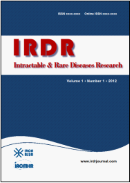Intractable Rare Dis Res. 2025;14(2):128-134. (DOI: 10.5582/irdr.2024.01078)
Clinical and genetic analysis of ulnar-mammary syndrome caused by a novel TBX3 mutation in a Chinese boy
Yang JM, Yu HM, Sun Y, Chen C, Li GM, Xu C
Ulnar-mammary syndrome (UMS) is caused by TBX3 mutation and is a disorder characterized by altered limb, breast, tooth, hair, apocrine gland, and genital development. The clinical and genetic data of a 5.5th boy with UMS were carefully analyzed. Clinical biochemical data, pituitary MRI, and whole exome gene detection were analyzed. The impact of the mutation and stability of TBX3 on the mRNA structure was analyzed by the M-fold program. Three-dimensional protein structures were calculated and analyzed. The patient presented with a hypoplastic left fifth finger, an absence of interphalangeal creases, a large space between the fourth and fifth fingers, no bending ability of the fifth finger, absent nipples, high palates, a flat nasal bridge, a micropenis, micro-testes, short stature and reduced axillary sweating. Pituitary magnetic resonance imaging (MRI) revealed pituitary gland hypoplasia with a thin pituitary stalk and loss of a strong signal in the posterior pituitary. A novel variant (c.1142_1146) in the TBX3 gene was detected in the proband and further verified by DNA sequencing. M-fold results revealed that the variant altered the mRNA structure and stability of the TBX3 gene. Clinical, genetic, and biochemical studies confirmed that the congenital normal idiopathic hypogonadotropic hypogonadism was associated with pituitary hypoplasia. After half a year of treatment with human chorionic gonadotropin (HCG), the micropenis was significantly improved. After 3.5 years of treatment with recombinant human growth hormone, the body height was largely improved. One novel variant of the TBX3 gene was confirmed in an UMS patient, which enriched the spectrum of TBX3 genotypes.







